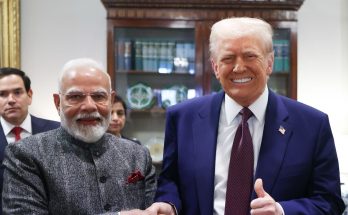
With China becoming more assertive in pressing its sovereignty claims on the contested South China Sea, the Quad countries are set to become more proactive in countering China’s tactics of control, which now includes an elaborate stratagem of legal warfare. Issues relating to Chinese activities in South China Sea will figure in discussions at the meeting of foreign ministers of Quad countries, including the US, Australia, India and Japan in Canberra on February 11.
Ahead of the Quad ministerial meeting, Australia’s Defence Minister Peter Dutton said in an interview that the US and its allies need to push back harder against China after they “acquiesced and allowed” Beijing to expand its footprint in the South China Sea over the past decade. “If we continue on that trajectory, then I think we’ll lose the next decade,” Mr Dutton said. Mr Dutton’s comments indicate the growing intensity of resentment in key world capitals against China’s perceived attempts to subvert the rules-based maritime order in South China Sea.
The first in-person summit of the leaders of Quad countries on September 24, 2021 had underlined the Quad’s commitment to “champion adherence to international law, particularly as reflected in the UN Convention on the Law of the Sea (UNCLOS), to meet challenges to the maritime rules-based order, including in the East and South China Seas.”
Besides the Quad meeting, issues relating to South China Sea will also figure high on the agenda of the 2+2 meeting between foreign and defence ministers of India and the US, likely to be held in March this year.
Besides South China Sea, the Quad ministerial meeting will focus on implementations of key deliverables that emanated from the first in-person summit of leaders on September 24. These include operationalisation of the Quad Vaccine Initiative, resilient supply chains for semiconductors and clean energy and setting principles on development of critical and emerging technologies.
China’s Gameplan
Beijing’s relentless attempts to rewrite rules of engagement in South China Sea has triggered a backlash not only among claimant states, but also the international community. Recent satellite imagery has shown China’s efforts to reclaim the land in the South China Sea by increasing the size of islands or creating new islands. China has also reportedly constructed ports, military installations and airstrips, particularly in the Paracel and Spratly islands. US officials tracking developments in SCS said that the pace of construction on Woody Island remains high and China is continuing to install new facilities and structures there. Officials said that the island, located in the Paracel Island group, can serve as China’s blueprint for future military developments in other Chinese-occupied South China Sea islands, including the Spratlys. China, Taiwan, and Vietnam have competing territorial claims on Woody Island.
India: BrahMos Strategy

Against this backdrop, India has sealed an agreement to BrahMos missiles, produced as part of India-Russia joint venture, to the Philippines to strengthen Manila’s deterrence against China in the South China Sea. The 375 million USD BrahMos sale has sent a signal to the region that India will be more proactive in countering Chinese designs in South China Sea. As part of this strategy, India will also be expediting negotiations with Vietnam, Indonesia and Thailand, key ASEAN countries, for selling BrahMos missiles. Indonesian Defence Minister Prabowo Subianto has already conveyed Jakarta’s interest in acquiring BrahMos during his visit to New Delhi in July 2020. BrahMos is a joint collaboration between India and Russia and is capable of being launched from land, sea, sub-sea and air against surface and sea-based targets and has been long inducted by the Indian armed forces.
Going forward, India is planning to intensify joint exercises with navies of claimant states, including the Philippines, Thailand and Vietnam. Bolstering capacity building and defence infrastructure of ASEAN countries will be an important part of India’s strategy to counter China’s aggressiveness in the South China Sea and the region, said officials.
India has vital economic, diplomatic and strategic interests in the waters of the SCS. The resource-rich SCS includes an estimated 190 trillion cubic feet of natural gas and 11 billion barrels of oil in proved and probable reserves. India uses the SCS waterways for trade worth nearly US$200 billion every year. Nearly 55 percent of India’s trade with the Indo-Pacific region and global trade worth US$3 trillion worth of trade passes through the sea lanes of communication in SCS.
The US has countered recent moves by China to consolidate its claims over the SCS. Taking note of China’s continuing reclamation and militarization of features of South China Sea, a recent report by the US state department concluded that China’s activities in the South China Sea, including its “historic claims” on almost all parts of the vital trade route “gravely undermine the rule of law” in the oceans and universally-recognised provisions in international law. The US will continue to challenge China’s assertive territorial claims and land reclamation efforts by bolstering support for Southeast Asian nations.
Shifting Goalposts

China has been shifting its goalposts to expand its claims on the contested South China Sea. This change in tactic is exemplified by China’s use of “lawfare,” as reflected in Beijing’s shift from the so-called ‘nine-dash line’ toward a new legal theory based on Four-Sha to buttress its claims in the South China Sea (SCS).
Four Sha’ or ‘four sands’ is linked to Nanhai Zhudao, a Chinese term used for the South China Sea. From China’s point of view, Nanhai Zhuhao has historically been its territory marked by four islands: Dongsha Qundao, Xisha Qundao, Zhongsha Qundao, and Nansha Qundao. These islands are also known as Pratas Islands, Paracel Islands, the Macclesfield Bank area, and Spratly Islands. A new US state department report has challenged the legality of China’s claims in the South China Sea.
In yet another attempt to promote its territorial claims, China has maintained that foreign militaries are not able to conduct intelligence gathering activities in its Exclusive Economic Zone (EEZ). The US has countered this argument by stressing that claimant countries, under the UN Convention of the Law of the Sea (UNCLOS), should have freedom of navigation through the EEZs in the sea. The United States has stepped up its military activity and naval presence in the region which includes freedom of navigation operations (FONOPs), which was established in 2018.
Code of Conduct
With China resorting to new tactics to consolidate its territorial claims over the whole of South China Sea, it’s time for ASEAN to push hard for an expeditious conclusion of code of conduct. China’s tactics of delaying negotiations have antagonised the region. India signalled a shift in its stand on SCS at the 15th East Asia Summit in November 2020 when External Affairs Minister S. Jaishankar said that Chinese actions and incidents in the South China Sea had eroded trust in the ongoing negotiations on the proposed code of conduct in the region. He also stressed that the negotiations should not be “prejudicial to legitimate interests of third parties and should be fully consistent with the UN Convention on the Law of the Sea (UNCLOS). “If you look at the South China Sea issue, from the point when they offered to negotiate a code of conduct sometime in 2001 or 2002, it has taken them more than 20 years simply to come up with just a framework. As of now, there is no code of conduct. The only thing that has changed is the facts on the ground,” said Vijay Gokhale, a former foreign secretary and India’s former ambassador to China, in an interview with The Hindu. “Having changed the facts on the ground, they are now in a position to dictate terms simply because these facts cannot be reversed. They have then brought in a border law which legalises this by saying there is no dispute and this is a matter of sovereignty. There are lessons for us to draw from this,” he added.

Going forward, with South China Sea emerging as a regional flashpoint, one can expect extra-territorial powers and stakeholders such as India and the US to become more proactive to thwart China’s expansionist agenda in the SCS. To counter China’s agenda in South China Sea, India will be working more closely with like-minded countries in the Indo-Pacific such as the Quad countries. Given its high stakes in freedom of navigation, India, in accordance with its Act East policy, should play a bigger role in the region and enhance capacity of its key partners such as Vietnam in countering unilateral attempts by China to expand its territorial claims in SCS. In this context, the ministerial meeting in Australia will position the Quad as a powerful force for upholding freedom of navigation and for shaping a rules-based global maritime order.
Author Profile

- Manish Chand is Founder-CEO and Editor-in-Chief of India Writes Network (www.indiawrites.org) and India and World, a pioneering magazine focused on international affairs. He is CEO/Director of TGII Media Private Limited, an India-based media, publishing, research and consultancy company.
Latest entries
 India and the WorldApril 21, 20253T Template for India-US Mega Partnership
India and the WorldApril 21, 20253T Template for India-US Mega Partnership India and the WorldFebruary 14, 2025Modi-Trump COMPACT: India, US launch MEGA partnership for 21st century
India and the WorldFebruary 14, 2025Modi-Trump COMPACT: India, US launch MEGA partnership for 21st century India and the WorldJanuary 28, 2025Modi, Trump talk global peace, focus on strategic connect
India and the WorldJanuary 28, 2025Modi, Trump talk global peace, focus on strategic connect India and the WorldDecember 16, 2024Kazan Spirit: India, China SRs to hold talks in Beijing
India and the WorldDecember 16, 2024Kazan Spirit: India, China SRs to hold talks in Beijing







